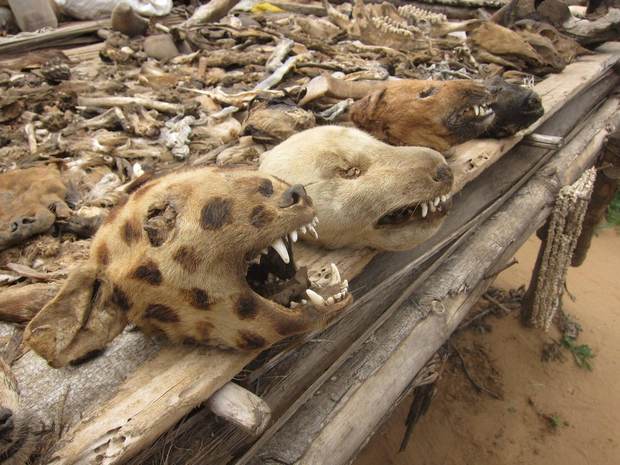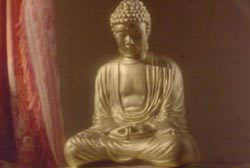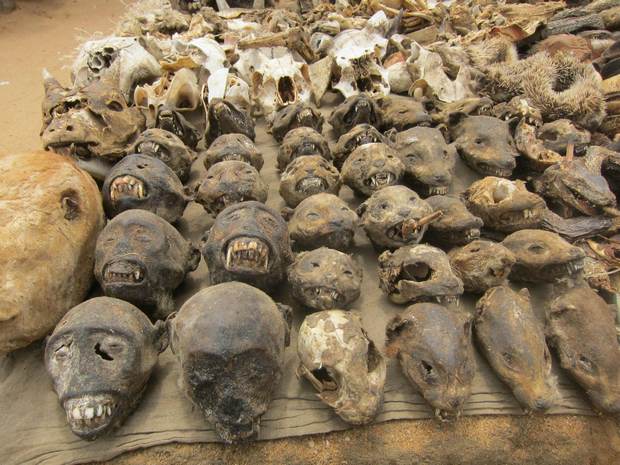In
the heart of Togo's capital, Lome, is a market dedicated to the sale of
ingredients which traditional healers say can make magic charms.
Togo’s Akodessewa Fetish Market is recognized as the largest fetish
market in the world, a place where Voodoo practitioner can find anything
they need for their rituals.
The practice of voodoo began in West Africa, before being taken to
America by slaves, and in countries like Togo, Ghana, or Nigeria the
religion is very much alive. Many people believe healers using animal
parts and strange talismans can invoke spirits with their bizarre
rituals, and solve their problems. And if there’s one place where voodoo
priests can stock up on their creepy supplies, it’s the Akodessewa
Fetish Market, in Togo’s capital city, Lome. Just think of it as an
outdoor pharmacy where various animal parts, bone statues and herbs take
the place of conventional medicine.

People who practise the voodoo tradition believe that life derives from
the natural forces of earth, water, fire and air. Joseph, a healer from
neighbouring Benin, says:
"This place is like a pharmacy for everybody in the world. When someone
has a serious sickness and the hospital cannot help, they come here to
the fetish market."
In the Togo’s capital, Lome, is strange market offering voodoo supplies
and ingredients that helps in traditional healing. People who practice
voodoo in Togo, believe that healing and life comes from natural
elements earth, water, fire and air. Even the pictures bellow are
disturbing for the most of us, people in Lome comes at this specific
place for medicines when doctors and hospital can’t help. The market
itself features all kind of animal heads; crocodiles, all kind of cats
and monkeys, birds, snakes, chameleons and much others. Good news is
that the animals are not hurt or killed, instead salesman’s collect
parts of dead animals and then sell them to people who need help. The
marketers in the Togo’s capital claim they are able to heal Fertility,
all kind of illnesses, to keep houses safe, even to help people in
sports to get luck . As mush we are concerned, voodoo is black magic and
we don’t encourage anybody to try it…
Voodoo Fetish Market, Africa’s Voodoo Supermarket http://www.theunexplainedmysteries.com/Voodoo-Fetish-Market-Lome-Togo.html

Yamashita's gold
Yamashita's gold, also referred to as the Yamashita treasure, is the
name given to the alleged war loot stolen in Southeast Asia by Japanese
forces during World War II and hidden in caves, tunnels and underground
complexes in the Philippines. It is named for the Japanese general
Tomoyuki Yamashita, nicknamed "The Tiger of Malaya". Though accounts
that the treasure remains hidden in Philippines have lured treasure
hunters from around the world for over fifty years, its existence is
discounted by most experts. The rumored treasure has been the subject of
a complex lawsuit that was filed in a Hawaiian state court in 1988
involving a Filipino treasure hunter, Rogelio Roxas, and the former
Philippine president, Ferdinand Marcos
The looting and the alleged cover-up
Prominent among those arguing for the existence of Yamashita's gold are
Sterling Seagrave and Peggy Seagrave, who have written two books
relating to the subject: The Yamato Dynasty: the Secret History of
Japan's Imperial Family (2000) and Gold Warriors: America's Secret
Recovery of Yamashita's Gold (2003). The Seagraves contend that looting
was organized on a massive scale, by both yakuza gangsters such as
Yoshio Kodama, and the highest levels of Japanese society, including
Emperor Hirohito. The Japanese government intended that loot from
Southeast Asia would finance Japan's war effort. The Seagraves allege
that Hirohito appointed his brother, Prince Yasuhito Chichibu, to head a
secret organization called Kin no yuri ("Golden Lily"), for this
purpose. It is purported that many of those who knew the locations of
the loot were killed during the war, or later tried by the Allies for
war crimes and executed or incarcerated. Yamashita himself was executed
by the U.S. Army for his war crimes on February 23, 1946.
The stolen property reportedly included many different kinds of
valuables looted from banks, depositories, temples, churches, other
commercial premises, mosques, museums and private homes. It takes its
name from General Tomoyuki Yamashita, who assumed command of Japanese
forces in the Philippines in 1944.
According to various accounts, the loot was initially concentrated in
Singapore, and later transported to the Philippines. The Japanese hoped
to ship the treasure from the Philippines to the Japanese Home Islands
after the war ended. As the War in the Pacific progressed, U.S. Navy
submarines and Allied warplanes inflicted increasingly heavy sinkings of
Japanese merchant shipping. Some of the ships carrying the war booty
back to Japan were sunk in combat.
Lost Treasure: Ferdinand Marcos Gold Buddha



